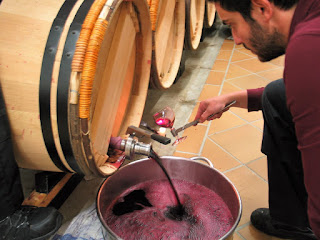by Paige Donner (all photos copyright 2017 Paige Donner)
As Bordeaux's very first wine château, is it any wonder that Haut-Brion still ranks with such stature in the world's profile of wines and wine estates? Well, a measured answer would be both yes, and no.
It's not a given that a wine or a wine estate with such deep-roots and a glorious past would be sheparded forward through the centuries in a fashion that continues to uphold what is best of the property and best for the wine.
On a recent visit to Château Haut-Brion, my first visit, in fact, I was told by the lovely Turid, the château's press relations manager who has been with the property for 17 years, that Château Haut-Brion is rightfully considered the very first Bordelais wine-producing château as they have come to be known through the ages. Meaning: vineyards, wine production area, chai, vat room, cellars and in Haut-Brion's case, even a cooperage.
As many French, and it's said the Bordelais in particular, tend to wax eloquent about the history and cultural significance of their properties, I had always taken this singular claim as the original Bordeaux Château with a grain of salt. BUT, I stand to be corrected. As the charming Turid pointed out, and later I was able to verify through my own research, indeed, it was as far back as 1533 that Jean de Pontac bought what was then considered to be a mansion that sat on the locality known as Haut-Brion in the commune of Pessac and united it with his surrounding vineyard land-holdings.
Thus, it can rightfully be claimed, through historical land records, that Château (& vineyards) Haut-Brion came into existence in 1533.
But that is not all that Jean de Pontac did. By 1549 he started building and enlarging on the very site that is still the château today and in fact the north-eastern part of the current château still constitutes this edifice.
Fast-forward a century or so and the château, always owned by illustrious men of power and King's servants, has gained immeasurable repute for its terroir and its resulting wines. So much so that in 1677 a (famous) philosopher by the name of John Locke, on a visit to the estate, is quoted as saying,
"The wine of Pontac, so revered in England, is made on a little rise of ground, lieing open most to the west. It is noe thing but pure white sand, mixed with a little gravel. One wold imagin it scarce fit to beare anything...."
That is probably one of the most remarkable things about Haut-Brion, a Gascon name that derives from its ancient Celtic origins of "Briga," meaning rise or mount, that traces of wine production here date back to the 1st c. AD. Hence as far back as Pax Romana times, this little hillock with its characteristic small white stone gravel soils has been recognized as being especially conducive to growing grape vines.
First Growth, Bordeaux Grand Cru
On the 25th of May, 1787, America's great lover of wine, Thomas Jefferson, who at the time was the 2nd American Ambassador to France, visited Haut-Brion during a tour of Bordeaux. According to historical record, this is what Mr. Jefferson had to say about Haut-Brion:
READ MORE ON https://localfoodandwine.wordpress.com/2017/07/05/a-flask-of-chateau-haut-brion-wine/
For photos contact: PaigeDonner.info
#BordeauxFoodAndWine







No comments:
Post a Comment